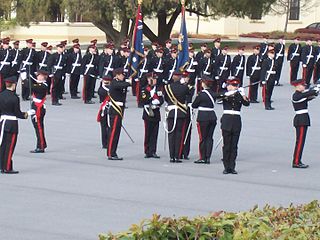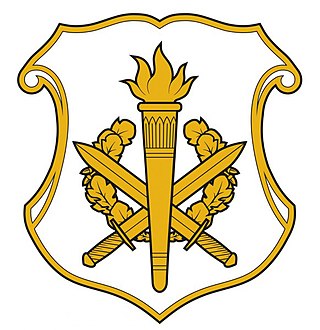
A military academy or service academy is an educational institution which prepares candidates for service in the officer corps. It normally provides education in a military environment, the exact definition depending on the country concerned.
Military ranks are a system of hierarchical relationships within armed forces, police, intelligence agencies and other institutions organized along military lines. Responsibility for personnel, equipment and missions grow with each advancement. The military rank system defines dominance, authority and responsibility within a military hierarchy. It incorporates the principles of exercising power and authority into the military chain of command—the succession of commanders superior to subordinates through which command is exercised. The military chain of command is an important component for organized collective action.
A lieutenant is a junior commissioned officer rank in the armed forces of many nations, as well as fire services, emergency medical services, security services and police forces.
Second lieutenant is a junior commissioned officer military rank in many armed forces. The lowest officer rank, it is usually placed below lieutenant or first lieutenant.
An officer candidate school (OCS) is a military school which trains civilians and enlisted personnel in order for them to gain a commission as officers in the armed forces of a country. How OCS is run differs between countries and services. Typically, officer candidates have already attained post-secondary education, and sometimes a bachelor's degree, and undergo a short duration of training which focuses primarily on military skills and leadership. This is in contrast with a military academy which includes academic instruction leading to a bachelor's degree.
A midshipman is an officer of the lowest rank in the Royal Navy, United States Navy, and many Commonwealth navies. Commonwealth countries which use the rank include Canada, Australia, Bangladesh, Namibia, New Zealand, South Africa, India, Pakistan, Singapore, Sri Lanka, and Kenya.
First lieutenant is a commissioned officer military rank in many armed forces; in some forces, it is an appointment.
The United States service academies, also known as United States military academies, are federal academies for the undergraduate education and training of commissioned officers for the United States Armed Forces.
Ensign is a junior rank of a commissioned officer in the armed forces of some countries, normally in the infantry or navy. As the junior officer in an infantry regiment was traditionally the carrier of the regimental colours, the rank acquired the name. This rank has generally been replaced in army ranks by second lieutenant. Ensigns were generally the lowest-ranking commissioned officer, except where the rank of subaltern existed. In contrast, the Arab rank of ensign, لواء, liwa', derives from the command of units with an ensign, not the carrier of such a unit's ensign, and is today the equivalent of a major general.
A cadet is a student or trainee within various organisations, primarily in military contexts where individuals undergo training to become commissioned officers. However, several civilian organisations, including civil aviation groups, maritime organisations, and police services, also designate their trainees as cadets.
Officer cadet is a rank held by military cadets during their training to become commissioned officers. In the United Kingdom, the rank is also used by members of University Royal Naval Units, University Officer Training Corps and University Air Squadron; however, these are not trainee officers with many not choosing a career in the armed forces.
Officer candidate or officer aspirant (OA) is a rank in some militaries of the world that is an appointed position while a person is in training to become an officer. More often than not, an officer candidate was a civilian who applied to join the military directly as an officer. Officer candidates are, therefore, not considered of the same status as enlisted personnel.
Subordinate officer is a term used in some armed forces for a grade of officer above a non-commissioned officer but still not actually commissioned, usually still in training. Such officers are treated for most intents and purposes as commissioned officers.
Fähnrich is an officer candidate rank in the Austrian Bundesheer and German Bundeswehr. The word Fähnrich comes from an older German military title, Fahnenträger, and first became a distinct military rank in Germany on 1 January 1899. However, Fähnrich ranks are often incorrectly compared with the rank of ensign, which shares a similar etymology but is a full-fledged commissioned officer rank.
Seekadett is a military rank of the Bundeswehr and of former German-speaking naval forces.

The Estonian Military Academy is an institution of applied higher education for national defence in Tartu, Estonia.
A new law approved in July 2008 changed the military ranks of Venezuela, principally with regard to names, functions and commanding regulation of the armed forces. The law was sanctioned by Venezuela's National Assembly.

An officer is a person who holds a position of authority as a member of an armed force or uniformed service.
Rank insignia in the French Air and Space Force are worn on the sleeve or on shoulder marks of uniforms
The military ranks and insignia of Chile are the military insignia used by the Chilean Armed Forces.


